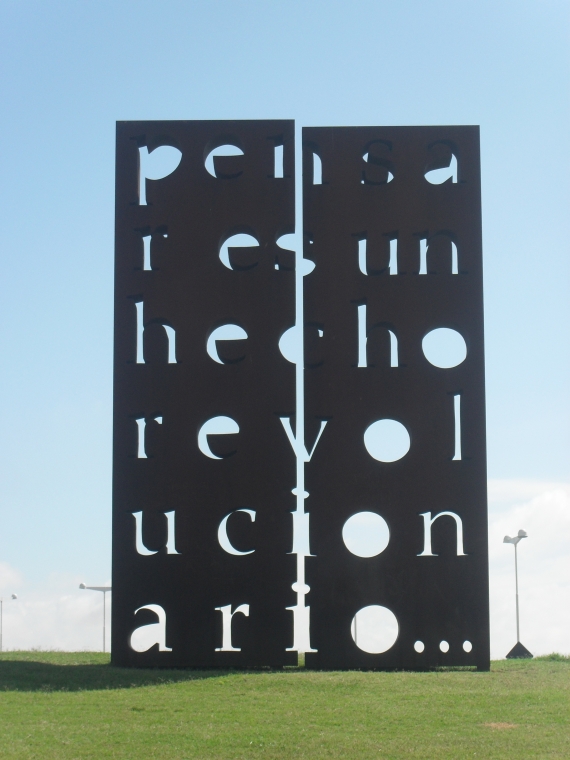Kyle Shepard,
'13
"Pensar es un hecho revolucionario"
Going into this
trip, I felt that I had a relatively good grasp on what to expect when visiting
the museums, parks, and former detention centers. However, I would only come to
realize after reflecting upon our visits to each specific place the
sociopolitical implications that the presence and preservation of these spaces
has had in Argentinean society. The experiences themselves of visiting each
site would produce a range of emotions for me, from mostly eye-opening
disbelief when seeing the actual spaces where Argentinean citizens were
tortured at ESMA and Olimpo (former detention centers), to a lone
un-self-conscious smile when viewing a work of art at the Parque de la Memoria.
All in all, what I would get out of this trip would be representative of the
purpose of many of the sites we visited: not necessarily to mourn over what
occurred in these spaces, but more to think and reflect about what
happened.
On the second day
of the trip, we visited ESMA, Escuela Superior de Mecánica de la Armada,
which specifically pertains to our class because it is an "Espacio para la
Memoria sobre el Terrorismo de Estado." What this means is that this site, as a
former detention center used for torture, represents a place where the defense
of human rights is promoted and the memory of tragic events are re-enforced
into one's memory. Seeing the actual basement of the building where
Argentineans were tortured was eye-opening in itself. The actual rooms have not
been preserved, but the layouts of the basement are clearly defined and show
how it had changed throughout its years as a torture center. Just being able to
visualize the tiny spaces in this small, open room where people were tortured
was definitely enough to put me in a state of astonishment. It's one thing to
see things like this in movies, and it is another thing to actually go to the
places in which such atrocities occurred. It's easy to believe how movies
attempt to portray how things happened, but it's another thing to put those
attempts to the test through experiencing a historical place in person. Even
though the movies we have watched have portrayed places like this pretty
realistically by using former sites in their footage, it just isn't possible to
do it justice.
On the fourth day,
we set out to visit Parque de la Memoria, which was my favorite site. The park
itself is essentially a wide-open space that allows for its visitors to walk
around and take in the works of art and panels of information around and inside
the premises. As we were walking around the park, I noticed further away a tall
monument that had letters carved into it, forming a phrase. When we got closer,
I could make out the words: "Pensar es un hecho revolucionario," which means
'To think is a revolutionary act." I wasn't quite sure what it meant at first,
but after thinking a bit about it, I couldn't stop wondering and confirmed
(after asking the tour guides) that it not only had significance in the past
but that it continues to resonate today as well. What it refers to in the past
is how Argentinean citizens were kidnapped and taken away essentially for their
way of thinking. If you were an activist who thought differently than the
government's ideology, you were considered a threat or a revolutionary and were
disappeared or silenced. Today the quote continues to have significance because
it symbolizes how thought is such a powerful tool and vehicle for expressing
one's ideals. Thought was considered to be revolutionary in the past in
Argentina; today it serves as a means of not only remembering what has
happened, but as a platform for further analyzing a situation. Specifically,
these words call for the use of thought every day to fight against injustice,
and to make sure that one does not repeats one's mistakes. After contemplating
this monument and talking with the tour guides, I found myself smiling at this
amazing and progressive work of art. I am glad that it is open to the public to
view and I can only hope that it will have as profound an impact on someone
else as it had on me.

Parque de la memoria (Buenos Aires, Argentina)
Reprinted
by permission of Omayra Batista © 2012 Omayra Batista
After watching
many films, which are commonly grouped as "cine de la dictadura," often times
in class we have been challenged to figuratively put ourselves in the shoes of
the Argentinean people (especially in those of who were tortured). The times in
which I attempted to do this I failed to truly and figuratively put myself in
their shoes. How could I articulate how these people truly felt when I have
absolutely no experiences in my life that I could use for comparison? I could
speculate how they potentially felt but I realistically couldn't understand
completely, and after going on this trip I still can't justifiably.
Nevertheless, what I do feel like I can do now after the trip and visits to
sites such as I have mentioned is further analyze the films we have watched and
materials we have studied in class on a much deeper level, based on what I have
physically seen and learned in Argentina. I have definitely gained a broader
and more in-depth perspective concerning the aims and objectives of the films
that we have watched thus far and this has enhanced my enjoyment and
appreciation for our class and for the sites we visited on our trip. |